Contents
This post deals with explicit sexual details that some may find disturbing. Reader’s discretion is advised.
The “sexual violation” of cows that many an animal activist argues against–some more vehemently than others–involves regular use of the term “forcibly impregnated.”
We’ll get more into detail later about what this means, but it’s important to bring this up now because it plays very heavily into the topic of breeding cows for two main reasons: 1) produce more offspring as “replacements,” and 2) producing more milk and more meat for the demanding human population.
Animal activists commonly use forcible impregnation to describe artificial insemination (AI) on dairy cows. The reason is simple: AI is used extremely commonly in dairy cows, especially in commercial confinement operations where the use of a bull for natural breeding is impractical (economically, mostly), as well as very dangerous. AI is also used on beef cows as well. Other ruminants where AI is sometimes used are sheep and goats. Small “hobby” non-commercial farms also use AI. The reasons that AI is used and preferred above breeding intact males (bulls, bucks, rams, etc.) will be discussed later.
Strong, vehement opposition to “sexually violating” the voiceless, innocent bovines (and other ruminants and non-ruminants like horses, pigs, and turkeys) is based on two main factors, which we will get to in a moment.
Of Quoted Claims and Emerging Truths
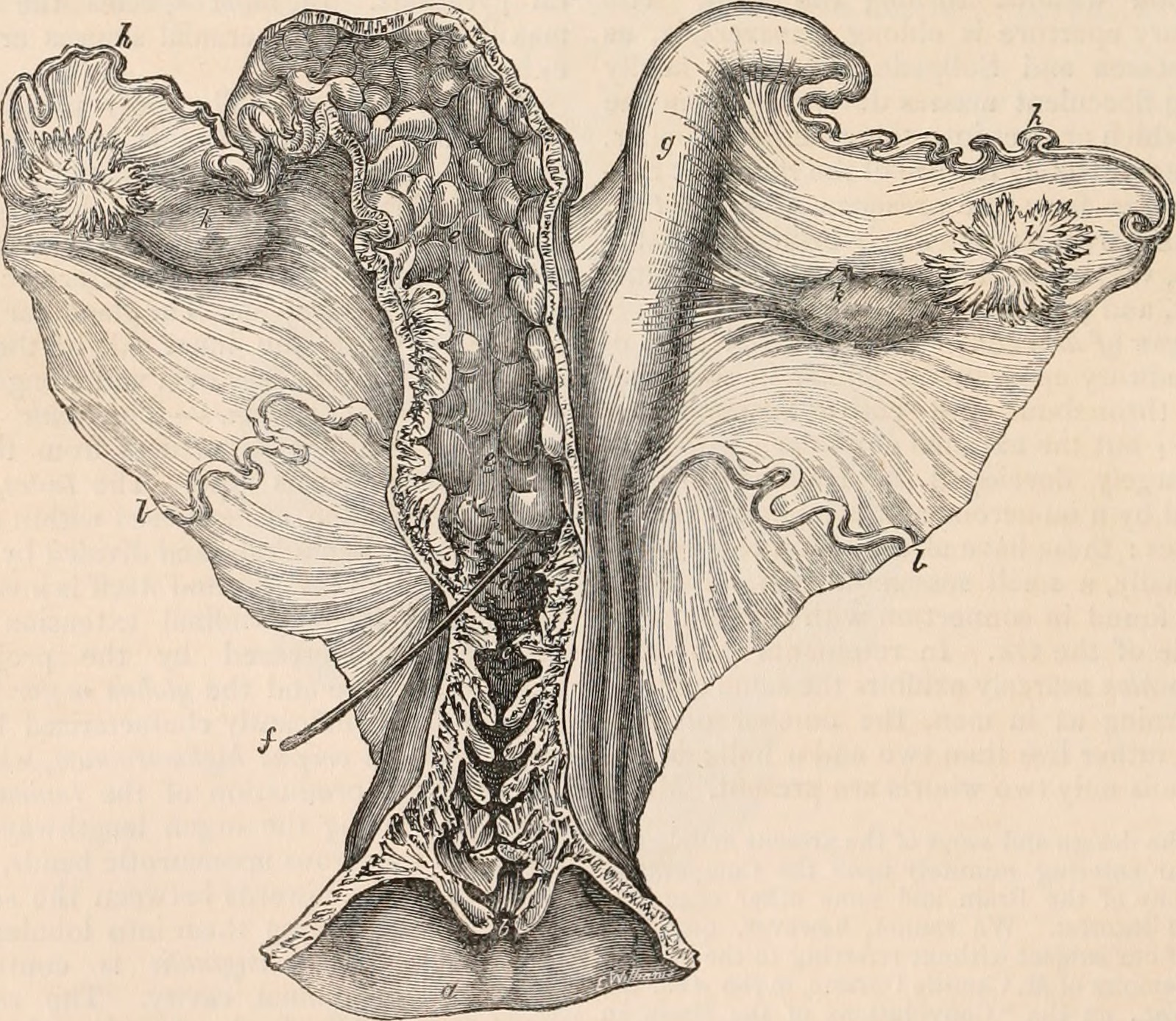
It’s difficult to point to who first coined the term “forced impregnation.” However, it undoubtedly came from one or more activists who wished to use a term that generated strong, negative emotions for the purpose of educating the public about how [dairy] cattle farming works. It’s an easy-to-recall term that, at least to the activists, encapsulates all the horrors that cows seem to be forced to go through to be “used and abused” for the dairy industry.
Here are some good gems from several famous activists that describe what we’ll be discussing and debunking shortly:
Female cows are strapped to a rack (common slang often refers to the device as a “rape rack”) and inseminated with semen stored in a massive syringe.
– James T. McWilliams, Forbes Magazine, 2013. “Milk of Human Kindness Denied to Dairy Cows“
All forms of dairy farming involve forcibly impregnating cows. This involves a person inserting his arm far into the cow’s rectum in order to position the uterus, and then forcing an instrument into her vagina. The restraining apparatus used is commonly called a “rape rack.”
– From HumaneMyth.org “Behind The Myths: Happy Cows“
When a human is forcibly and involuntarily violated sexually, it’s called “rape.” When animals on factory farms are forcibly and involuntary violated sexually, it’s called “artificial insemination.”
[…]
In order to force them to produce as much milk as possible, farmers typically impregnate cows every year using a device that the industry calls a “rape rack.” To impregnate a cow, a person jams his or her arm far into the cow’s rectum in order to locate and position the uterus and then forces an instrument into her vagina. The cow is defenseless [sic] to stop this violation.
– From PeTA “Is Your Food a Product of Rape?“
Joey: “..and when she can’t produce milk anymore, she’s murdered for her body, okay? Her mother…”
Host 1: “And so, the rape is the insemination?”
Joey: “Well, it’s forcible impregnation, isn’t it? If it was any… it’s, it’s the victim… if it was a human being we’d call it, what? What would we call it?”
Host 1 & 2: [after an awkward moment of silence] “[But it’s] it’s not a human being, it’s a cow… “
Joey: “It’s forcible… it’s sexual abuse…”
From VEGAN ACTIVIST EXPOSES DAIRY FARMERS ON LIVE TV [DEBATE] | Joey Carbstrong. Link: https://www.youtube.com/watch?v=vjgJvRx66OQ Quote taken from 2:20 mark.
Have you ever thought about forcibly impregnating your cat and then killing its children so that you can steal its milk? […] So few of us are exposed to how these animals are treated and killed. Ignorance is definitely one of the man driving forces behind speciesism…
A YouTube video clip from VeganGains.
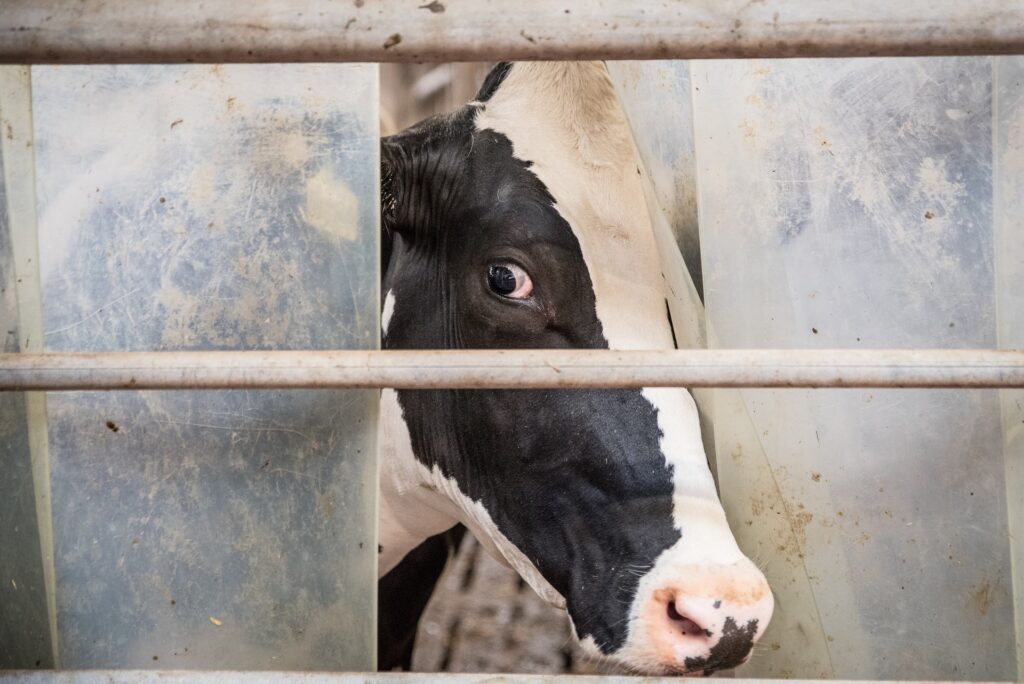
Finding out who first coined the terms “forcibly impregnated,” “sexually violated/abused,” or dared to apply the term “rape” to farm animals like dairy cows is beside the point. It’s a futile and unproductive rabbit hole to pursue. The big question to ask and answer is WHY. Why do these terms exist, and why have they gained such readily accessible lip service to anyone who identifies as an animal rights activist or ethical vegan?
Answering that question is easy. It comes down to two primary reasons:
- Human [mis]interpretation of bovine behaviour & psychology, and
- Grossness and disgust over the “ugly realities” of how animals are raised for food.
(ASIDE: I can also attest that a huge knowledge gap about farming practices is also a big reason. It extends far beyond just dairy farming. Many people have no idea where their food comes from and how it gets to the grocery store. Many are ignorant about the environmental, welfare, political and economic conditions that have made agriculture what it is today and how we desperately need to change it. Admittedly, this includes animal agriculture.)
With 99% of the population urbanized and distantly removed from the realities of agriculture, it should be no surprise that most have been led to believe that farming practices are this romantic, idyllic paradise where animals are happily frolicking in the fields, doing their thing.
It should also be no surprise that activists like those quoted above, and many more who faithfully follow them, felt outraged, angry, and betrayed when they found out the truth. Realizing that, to them, animals are being treated horrifically by the meat and dairy industries, they decide to abstain from using, wearing, and eating any and all animal products. They also decide it’s their obligation to educate the masses who are, to paraphrase what VG said above, “definitely ignorant of the truth.”
I agree that too many people are definitely ignorant of the truth. There is no question about that. Where vegan activists like Joey and Gains and I collide is how the truth is told. They make it sound like animals are brutally and wantonly tortured and live in appalling conditions when the evidence that I have seen and will put forward contrasts with those claims.
There are three parts we will discuss that debunk the forcible impregnation and rape-rack myths:
- Part 1 will talk about the human misinterpretation of bovine psychology. Understanding this section before proceeding to the next two will be crucial.
- Part 2 covers the negative emotions over the alleged “raping” of dairy cows for milk and the emotionally-charged, psychologically-damaging claims of lack of consent, dominance and control, and sexualization and bestiality. Finally,
- Part 3 covers the science of bovine reproduction, why AI is even used, the steps in how it’s performed, the dangers of breeding [dairy] bulls, the “rape rack” myth, the realities of breeding animals and working with domesticated, yet never socialized to human standards, livestock.
Part 1: Human Misinterpretation
People often inaccurately perceive how ruminants think, feel and behave. Some think they’re slow and stupid; others think they deserve to be treated like humans. Some think they’re cute and cuddly; others know their power and danger. Still, others see steaks or jugs of milk on legs, while others see living, breathing, sentient beings.
Regardless, having some acknowledgement of ruminant size and behaviour, though, sets the stage to busting the myth that [dairy] cows are sexually abused or forcibly impregnated [for milk].
Comparing Cow Size to Human Size
Most people, vegan and non-vegan alike, don’t realize just how enormous [dairy and beef] cows and cattle are. Some believe that these large ruminants are no bigger than a large dog or even a chicken. Shaun Baker, for example, had an amusing debate with a vegan influencer who demanded peer-reviewed evidence to prove that a cow was much bigger than a chicken.
Cattle are about ten times the size and weight of an average human. A healthy, fit 150-pound, five-foot-five-inch adult woman with a size 2 (25-inch) waist is much smaller and lighter than a healthy 1,500-pound mature dairy cow standing almost six feet at the shoulder, stretches over six feet from nose to tail and has a circumference between 120 to 150-inches around the belly. (A full-grown bull is even larger.)
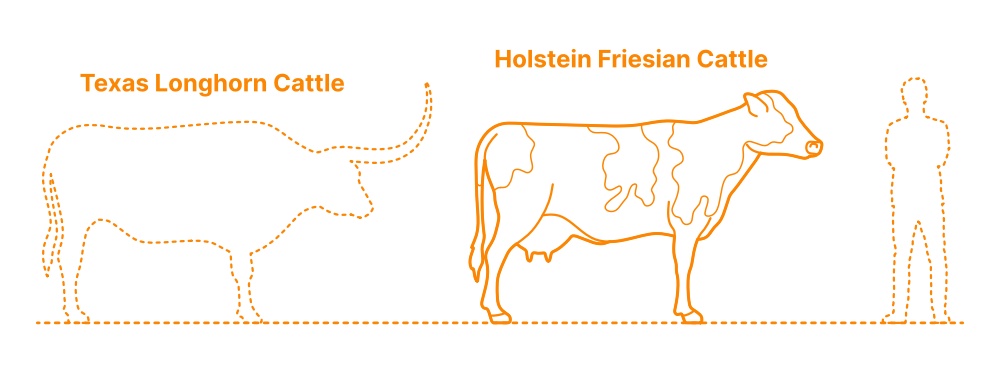
Therefore, as we’ll talk about later, a human arm up a cow’s anus is going to feel a lot less painful than the perverted lies these activists are telling everyone.
Not only that, but the biggest caveat of all is that human interpretation is based solely and finitely on human interpretation. You can never trust a cow to consider themselves just another four-legged furry human!
What We Know About Bovine Thoughts and Communication
Very, very few people understand bovine psychology and behaviour. Scientific literature has described it objectively in complex detail, with room for revision and improvement. However, reading books or papers doesn’t hold a candle to directly working with animals. The cows themselves are always the best teachers!
Those who have learned to appreciate bovine behaviour and psychology and use that knowledge to work with them calmly, safely, and with low stress are probably the best interpreters of all. Such people happen to be farmers, ranchers, or professionals in animal husbandry and welfare, not animal rights activists/vegans. Who knew?
And yet, we can’t really know how cows and other ruminants think. We can only interpret it based on our limited understanding of how they react to certain situations and “stimuli” and how they remember certain details and completely forget others. Our most educated assumption is that they live in the moment, concerning themselves mostly with eating, drinking, ruminating, and socializing with their herd mates. Mating and maternal/paternal behaviours only come about at certain times of hormonal importance. They don’t seem to think of the future nor dwell in the past. Their only hopes and dreams seem to be having tasty fodder to eat and having their closest friends/family they love to live with. They also appreciate being healthy, having access to shelter when it’s needed, and being free from fear and pain. It is a very simple life and existence, unlike what most of us have.
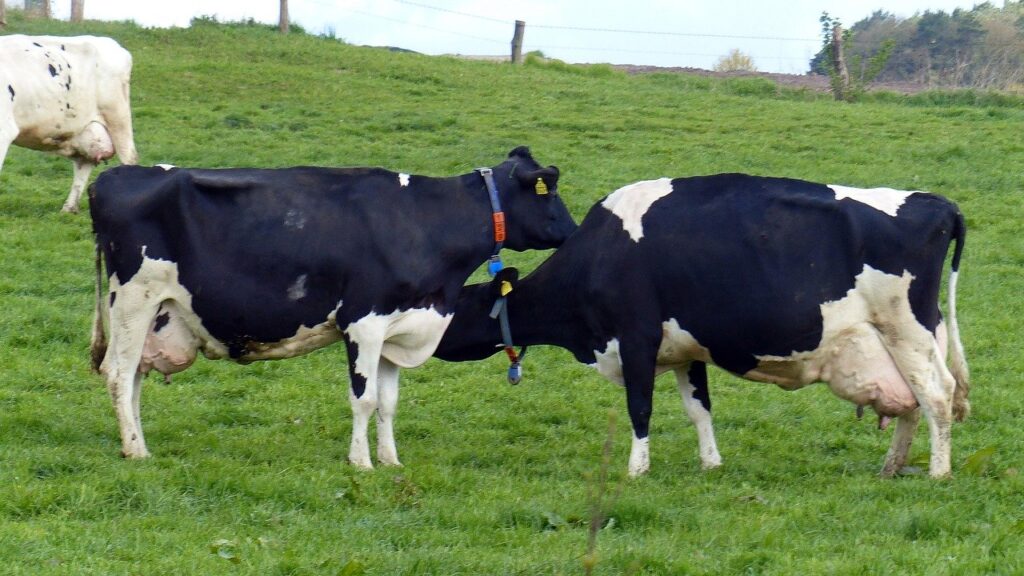
However, this is a limited understanding, and I could be quite wrong in this assumption. We know they’re not machines. They feel pain and have their own ways of expressing fear, excitement, sadness, frustration, happiness, contentedness and pleasure. We also know they deserve basic rights and freedoms to food, shelter, good healthcare, safety, and social inclusion with those of their kind.
They’re amazing at learning and problem-solving somewhat simple tasks that promise a food reward at the end. They learn positive or negative associations when they come into contact with a combination of colours, shapes, smells, objects, animals, people, articles of clothing, sights, sounds, different animals, and changes in the behaviour of their herd mates or the person[s] they’re most familiar with.
And, most importantly, remember that trick or habit they learned themselves… or from their herd mates. I will admit and unashamedly acknowledge that the above assumption doesn’t give these animals enough credit for being as intelligent and sentient as they’ve always been.
Just like us, they learn about and how to familiarize themselves with a wide assortment of things. They like routine and sameness but also get excited when something new disrupts their expected day-to-day activities! (Some more than others… just like us.)
Therefore, indeed, they are sentient beings.
However, that still doesn’t make them as intellectually competent as we are. Just because they’re proven to be sentient does not make them sapient. Sapience implies human-like characteristics, which they don’t have. That’s the textbook definition of anthropomorphism.
Cows are really, really good at being cows and doing cow things. So, it’s an impossible fantasy made possible only by those deluded (or intoxicated) enough to believe they’re a real-life version of Dr. Doolittle to believe that cows are anything close to being human-like. (They’re not “like big puppy dogs,” either. Sorry.)
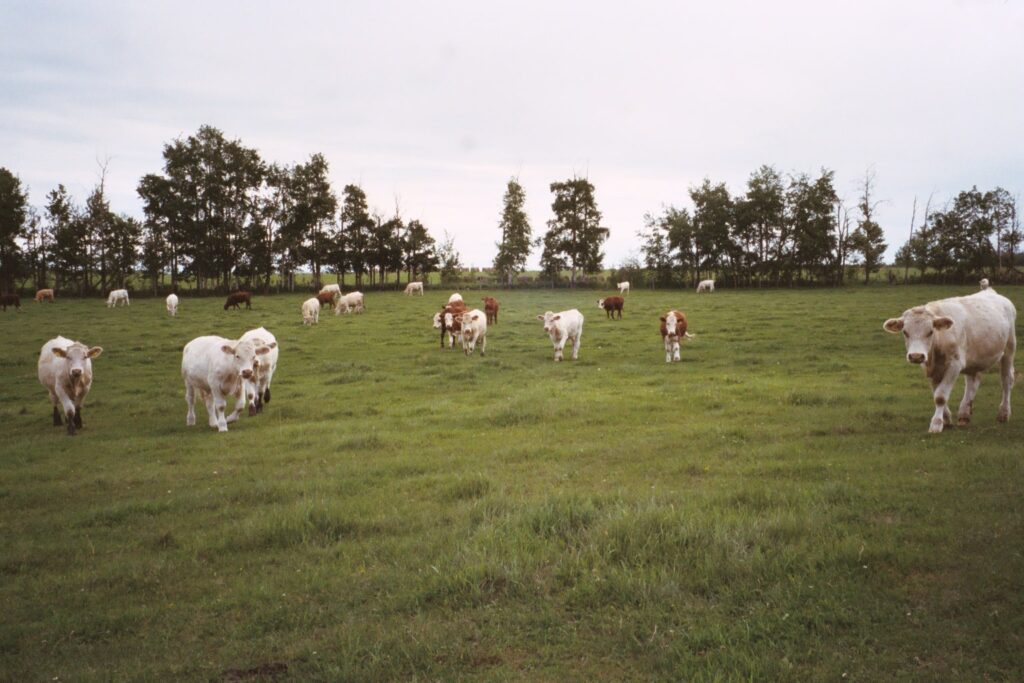
However, that also doesn’t mean ruminants are incapable of communicating with us, themselves, or other animals. Quite frankly, they’re very well-versed in it. Call it speaking Bovine. (But not Human.)
Mostly, they “talk” via body language, less by vocalizing (or “mooing” as we like to interpret it). They act in certain ways to establish dominance, court before mating, express pain and discomfort, eat and graze, stay with the herd, and so on. Most importantly, it is how they act when we are in their presence. They see us in a whole different light than we even think!
That’s the biggest reality check we all need to acknowledge and understand.
We often struggle to figure out what they’re trying to tell us; usually, it gets misinterpreted, ignored, or mistaken for something else entirely. Yes, even people who work with animals will miss the subtle (and not-so-subtle) cues. The consequences range from completely harmless to life-threatening, depending on the situation.
For instance, when talking about “lack of consent” (Part 2 below), animals are not afraid to tell us when they really don’t like what we’re doing to them. Just ask any practicing veterinarian!
All ruminants see us as predators. We’re not other ruminants to them. We don’t act, smell, look, or behave like one of them. Most aren’t comfortable with being really close to humans. Dairy cows are more comfortable with close human presence than beef cows, though it depends on the individual. Some cows have a “flight zone” that is just out of arm’s reach, others more than 100 feet (~30 meters). These animals won’t be fans of being touched, much less cuddled or petted.
The ones that will tolerate being touched have been thoroughly desensitized (or “socialized”) to where they’re as “tame” as a family pet. They’ve learned that humans are safe and are not going to hurt them. These “pets” are far less common than most would have you believe.
Then, there’s us. People don’t realize how we all are instinctual predators from day one. We need certain activities to help us express our innate predators without hurting or killing others. Fun-to-us games include chasing others in a game of tag or catch-me-if-you-can, stalking and scaring the living crap out of our loved ones, or finding entertainment in sports that involve seeking (hunting), chasing, catching, and possession of an inanimate object. There’s also some thrill in trying to beat the clock, being the most accurate in striking a target or taking a risk that is life- and/or financially threatening… I doubt ruminants share in this sort of fun!
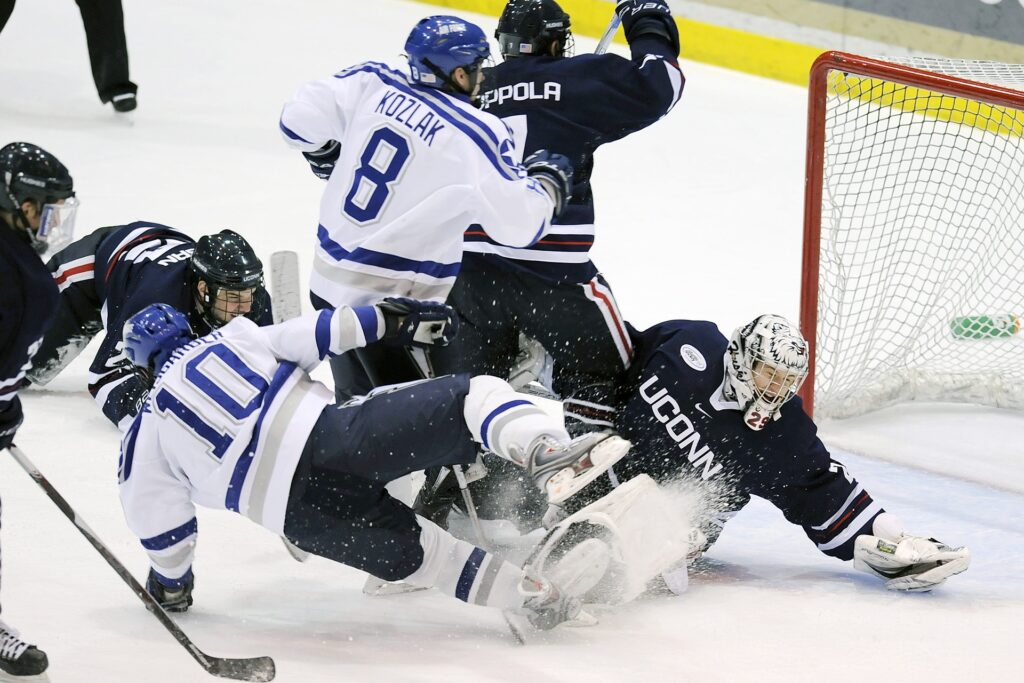
Our psyche behaviour is seemingly suppressed to many of us, but it’s still painfully obvious to the ruminant [prey animal] herbivore. They are always aware of it. Even the ones who are cute- or crazy-tame. But, those who aren’t at “pet status” are more wary, always on yellow or red alert to keep their distance, move out of the way, run for their lives… or turn and fight.
So, whenever you approach a “cute” strange cow, it’s guaranteed she will instinctually keep you at a safe distance. She can’t read your mind, only your body language. To her, you’re a threat of some level until you can prove otherwise.
It’s important to understand all the aforementioned so that we know how to respect them better. As we’ll discuss later in the following section, that doesn’t mean that we are also obligated to leave them alone and let them live their lives. We greatly influence their lives; thus, it’s our responsibility to do what needs to be done to best care for them and ensure they exist for future generations.
While the animals themselves will object due to the discomfort of being too close to humans and the procedures that need to be performed on them, the greatest and most vile objections come from other people. Animal activists have some pretty perverted and nasty reasons why artificial insemination is one such procedure that should never be performed on animals.
Part 2: Negative & Perverted Interpretations
Above, we saw how animal activists/vegans believe that “non-human animals” like cows are equal to humans: they supposedly have very similar emotional capacities as we do, are more intelligent than most of us realize, and have the same basic rights and freedoms that we desire and need ourselves. Activists draw the conclusion that these animals deserve to be treated and regarded like humans or as “persons.”
This belief is inherently flawed because cows are nothing like humans. However, it’s a belief that drives a lot of vitriol and disgust towards farmers and their alleged abuse, torture and cruelty towards animals in their care. (We will revisit this in other posts in addressing the allegations of slavery, murder, pedophilia and torture towards animals and their hatred of raising animals for profit.)
In the context of AI, activists strongly believe that cows are forced against their will to become pregnant. They believe that because cows are unable to give [verbal] consent, it’s a gross form of misconduct and abuse for a human to put an arm up the cow’s anus and a metal rod up her vagina to breed her.
This interpretation comes from imagining what it’s like to be a cow. They imagine being restrained against their will. Then they imagine themselves with an entire hand forced up their anus and a cold metal rod rammed into their vagina (men, you’ve no idea).
The former is a real and rather lewd erotica act called “fisting,” minus the metal rod. It’s where one person is on their hands and knees (sometimes restrained if it’s a naughty BDSM act) while their partner forces their hand into that person’s anus right up to the wrist. Apparently, the recipient achieves orgasmic climax despite the pain they must endure when the “fister” stimulates the right spot through the rectal wall.
Understandably, most will get grossed out by this version of “reality.” (We know a few of you will find it a turn-on, even though you will never admit it.) They get so disgusted that they automatically make false claims of the lack of consent, display of dominance, and alleged bestiality and sexualization of a veterinary medical procedure. So, they conclude that artificial insemination is very painful for a cow to go through, not to mention extremely traumatizing and, therefore, hatefully cruel.
But reality has a much different opinion that counters this perverted belief.
The Concept of “Lack of Consent”
Vegans will always argue that because cows (“non-human animals”) are equal to humans, they have the “right to bodily autonomy.” This claim quickly falls apart because these ruminants have no clue that we’re just trying to help them.
Cows don’t understand the concept of consent like we do. We’re the ones who are able to properly define it, especially in determining acts which are lawful or unlawful, or moral or immoral.
According to the Oxford Dictionary, the definition of consent is:
(noun) permission for something to happen or agreement to do something.
(verb) give permission for something to happen.
The antonyms of consent are disagreement, opposition, rejection, or refusal.
Rephrased: consent is the permission or agreement to be able to do something or allow something to happen.
In the context of rape, the victim is not consenting to the activity. They are forced to undergo unlawful sexual activity/intercourse against their will and/or under threat of bodily harm or death. Non-consenting individuals may also be those who cannot give valid consent due to their being underage, mentally ill, mentally deficient, intoxicated by drugs or alcohol, unconscious, or deceived.
The whole act and meaning of rape, therefore, is of consent or lack thereof. Rape is also defined in non-sexual terms as being an “outrageous violation” or the seizure and taking away of something (or someone) by force.
In the former definition of rape, being of sexual violence, sexual abuse, or sexual assault, all of such terms are directly in the context of [un]lawful human conduct. NOT of conduct towards animals, especially when it comes to veterinary medical procedures.
(Bestiality is considered a form of zoophilia “rape” because the animal is forced to be involved in the nefarious sexual activity of one or more humans and therefore is unable to consent. Certain countries and states have laws that make bestiality an illegal activity punishable by law. More on that later.)
Quite frankly, cows (and all other non-human animals) are unable to consent to anything that we have to, can do, or will do to them. It doesn’t matter if it’s for their own benefit or our idiotic wants and desires based on whatever nefarious, delusional, or faulty beliefs we may have about their health, welfare, and desires.
Guaranteed, they have no clue that we’re trying to help them and will be absolutely terrified when a painful procedure must be done that they won’t like. They will try to get away from us at any cost. (Some animals are a lot more trusting than others. When it comes to “livestock” like cows, they’re often far less trusting than a family pet.)
Frankly, when it comes down to decisions that must be made that affect their lives and which only we humans are best informed about, it’s our sole responsibility to enact those decisions regardless of whether the animal consents to such actions or not.
A cow will try to get away when she needs to be treated for an injury or sickness. Same if a person needs to get her out of trouble, like getting her head stuck in the fence.
A cow or heifer doesn’t know consent when it comes to breeding, either. She doesn’t know how dangerous and expensive bulls can be. She’s in heat, and her hormones are driving her (and her herdmates) mad.
On the other hand, [complete idiots] will catch an animal to perform nefarious, unlawful, and cruel activities on them. Use your imagination as to what that involves. Did the animal consent to that? Of course not.
Therefore, consent cannot be given by those animals either for the good intended for them or the evil that may be done to them.
What good is it to argue animals’ interpretation of consent (and “bodily autonomy”) when they have no clue about such concepts?
It’s more useful to debate what constitutes good welfare and animal husbandry. To ethically raise animals for food means understanding what truly is best for the animals in terms of welfare, health, productivity, and, when the time comes, their ultimate death.
That responsibility falls on our shoulders. We’re the ones that are to be held accountable because we are responsible for their care. The animals cannot make any of those decisions by themselves.
Unfortunately, there are times when the things we must do to animals involve some level of force and “dominance,” but always for the benefit of that animal. Sadly, certain people misconstrue such activities as a “deliberate show of human superiority via dominance and control.”
AI as a Deliberate Display of Dominance
Rape is often utilized as a show of power and control while the perpetrator also gets their sexual gratification from their victim. However, as already established, this is in the context of unlawful human conduct and is very wrongly associated with raising dairy cows for milk.
Animals, once again, do not understand such a human-derived construct. They don’t know whether or not AI is some “deliberate show of power and control.” This cannot be understated.
Artificial insemination, therefore, has nothing to do with exerting power and control. It is, after all, a veterinary medical procedure.
We humans already exert some form of power and control over animals by how we decide to feed, house, and handle our animals, from our pets to the livestock in our care. It is indeed intentional. But, it’s not designed so that they live in fear and carry trauma for the rest of their lives, unlike with a real-life (human) sexual assault victim.
The way cows are raised is (and should be) a win-win situation: the cows win because they get free shelter, free food, and great health care, and the human (farmer) wins because it’s a challenging, fun, and enjoyable way of life, and an income is made in selling a product (milk).
Cows don’t give a damn that money is made off of them. (Yet another human construct they have no comprehension of.) They only care about being treated well, fed well, and feeling safe and secure.
If they’re being abused and neglected, it really, really shows. The animals don’t lie; humans sure do. And we humans can do some pretty nasty, vile, disgusting stuff to animals that they don’t deserve.
Only the Perverted Would Sexualize Artificial Insemination
The final and most grievously perverted human [mis]interpretation of AI is its sexualization. This is where animal activists believe that anyone who does AI “gets off” on it, or rather does it for the sake of selfish sexual gratification.
The major problem is that it’s one of the biggest lies animal rights activists have ever told about the “evil” dairy industry; and, its source may very well be from those who are deeply, mentally disturbed, so much so that their sadism and zoophilia fetishes come out in a form that questions if they’re actually defending animals in the first place.
Outrageous claims like this make people wonder if those who are the makers of such claims are the very perpetrators who enjoy and want to continue seeing animals tortured and forced to perform sexual acts with humans (aka, bestiality). Why and who else would dare bring up something like this in a public conversation about dairy farming or raising animals for food? Is it a secret means to quench their vile carnal proclivity, but in a way that avoids shining a light on their indecent guilty pleasures?
The reality is that nobody else is making AI (or preg-checking) out to be some “legalized” form of bestiality except vegans and animal activists; especially the followers of PETA (People for the Ethical Treatment of Animals). Not the farmers, not the AI technicians, not those involved in selling bull semen to thousands of farms all over the world.
Nor is anyone else aligning AI to the erotic BDSM fetish of fisting or the imagination of “being a cow” and thereby being forcibly fisted. As mentioned above, it’s difficult to imagine being a cow when they’re 10 times our size and have less than a tenth of our intellect, if that.
But let’s talk about the disturbing realities of what actually constitutes bestiality.
In its true form, bestiality is not sticking the arm up a cow’s rectum. It’s a human performing a sexual activity with an animal for the purpose of that human’s sexual gratification.
This may entail a man sticking his penis in an orifice of an animal (mouth, nose, anus, or vagina) and utilizing that “space” until satisfaction is achieved, or a woman getting a male intact animal, be it a dog, horse, monkey, or whatever non-sapient species to vaginally or anally satisfy her.
Were the animals forced to interact in such a nefarious way? Most likely, yes. Would the animals that were involved in such interspecies sexual intercourse “enjoy themselves” in a way that they got their share of sexual gratification? Most likely, not.
Most likely, the animal was indeed forced against its will (was not consenting) to have sexual intercourse with a human. Would that not constitute sexual abuse or rape in its true form? It undoubtedly is animal cruelty and abuse, and while it’s not illegal all over the world, it very well should be.
However, AI (and preg-checking) has never been a sexual act. Just because it involves reproductive organs and understanding how sexual reproduction works doesn’t make it erotic or sexual in any way.
A human isn’t receiving sexual gratification with his or her entire arm up a cow’s rectum right up to the shoulder. No human sex organs are ever involved in such veterinary medical practices. So, why sexualize it? It’s disgusting, wrong, and beyond asinine.
Artificial insemination is also not about sexual gratification by the person performing artificial insemination. There is actually absolutely nothing sexual about this choice in management practice. The only people who have the gall to even think that AI (or rectal pregnancy checking) is some form of perverted sexual act are f*cked-in-the-head debauchées themselves. Sometimes I think that those who clamor about how cows are raped or jeer about A.I being equivalent to fisting or bestiality are disgusting, mentally-deranged dolts who want to see such abuse occur to animals, just so that they have something to quench their own abhorrent carnal proclivity with.
It makes no sense why vegan activists would even try to align A.I with some erotic fetish like fisting. Fisting is sticking one’s whole hand up someone else’s anus as a form of sexual pleasure; primarily for the one being fisted. Yes, it’s disgusting to those of us who have sensible sensibilities. But the only reason I can come up with that these extremists would dare consider such snuff porn is to imagine themselves as the cow getting an arm up their rectum.
Only problem is that a bovine’s rectal orifice is ten times the size of a human’s, so a human arm to a cow is basically like having a finger up your butt… just ask a man who had to have his prostate examined. With that imagery in your head, and because one has to put his or her whole entire arm up a cow’s rectum, wouldn’t that be called “arming” instead of “fisting”? Sorry, I’m being facetious, mostly because this entire discussion is just so bloody ridiculous.
As I already pretty clearly implied above, rectal palpation needs to be done as part of artificial insemination, and it sure as hell isn’t a sexual fetish. That bullshit is all in the heads of those who adore the idiocy that comes from the like of PETA (People for the Extinction of Tame Animals [oops, I mean “People for the Ethical Treatment of Animals”]), and equally seem to like to dabble in the darker, more vile parts of human nature.
As far as bestiality is concerned, artificial insemination doesn’t even fall under such a category. It’s pretty asinine to think that it does. You know what falls under the category of bestiality and sexual violation of a bovine? A man forcibly putting his penis in particular bovine orifices where it don’t belong. (And I highly doubt the cow is enjoying it as much as the foolish horny bastard is.) It’s bad enough that jokes come about from parts of Europe where a lonely man has a “companion” for a particular favourite sheep or goat, but a cow??
Seriously, bestiality is messed up and just plain wrong. And yes, it is animal cruelty and abuse. Especially when the animal is never able to give consent to have sexual intercourse with a human being. So, the next time a vegan starts screaming about how cows are getting raped, ask them what particular human sex organs were involved in such alleged “cow rapings” happening on factory farms. I guarantee they’ll come completely unhinged.
(Consent is another silly argument I’ll explore below.)
An artificial insemination technician does his or her job not because [s]he “gets off” on it. [S]He does it because it’s a lucrative business, it’s a service to the farmers who need to get some cows bred where a bull is unavailable or logically unattainable, and it’s a fun job, despite how physically demanding it is. (To hell with you who think I’m saying all this with double entendres…)
Lastly is the argument about consent. Let’s talk about that now.
Part 3: Ruminant Reproduction & How to AI a Cow
If we are to compare the similarities and differences between the reproductive tract of a woman and that of a cow, I would be able to tell you that there are quite a number of similarities.
Before I get to that, from here on out, please remember that when I mention the word “cow” (or plural “cows”), I specifically am referring to mature female bovines. There is no such thing as a “female cow;” not unless we’re talking very colloquially and loosely about cows as domesticated bovines in general, which we are not! I will not stoop to that level here. If you want to find out more specific definitions of cows and cattle, I highly recommend thatyou check out my Facts & Terminology page. It will help you better understand the quick and dirty facts on what cows are and what they aren’t.
A couple of photos will help me better describe what I’m about to talk about.
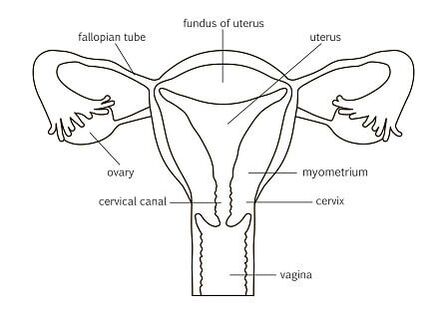
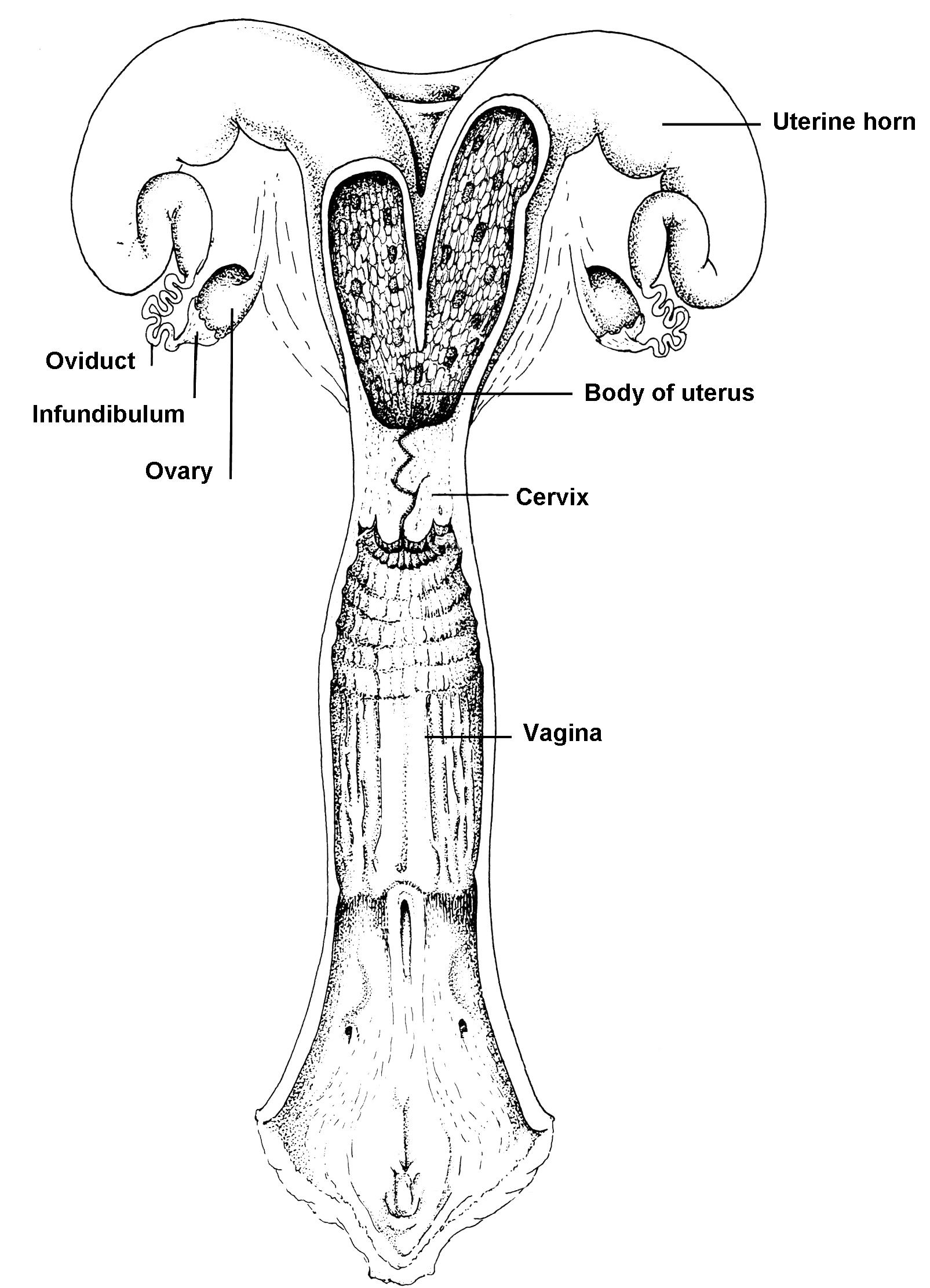
As mammals, humans and bovines have the basic similarities of sex organs including the clitoris, vagina, cervix, uterus, oviducts, and ovaries.
Both bovines and humans reproduce sexually; both “grow” the embryo-to-fetus within the uterus, with the fetus relying on an umbilical cord attached to the placenta–which is attached to the uterine wall–so that it can get the nutrition it needs and can also excrete wastes. Both also give birth to live young.
Both cattle and humans have a very similar gestation period which is around nine (9) months long. Both bovines and humans also usually give birth to only one offspring at a time. Twins, triplets, quadruplets, quintuplets, sextuplets, and even octuplets are quite rare, in that order.
The differences between women and cows begin anatomically-speaking. Cows have their uterus divided halfway into what are called “uterine horns.” Each horn narrows further down the line into oviducts, fanning out into an infundibulum that catches the “egg” (ovum) when released from the ovary.
The epithelial (skin) tissue within the uterine horns have bumps called “caruncles.” These bumps are where the placenta of the fetal calf attaches and exchanges nutrients with its dam. The human female does not have such appendages.
What the human female does have is the myometrium lining of the uterus. The cow does not have such a feature. This is unique to most primates, including humans. This uterine lining sheds during the follicular phase through a process called “menstruation.” Menstruation is a means to reject old myometrial tissue after the ovum that was previously released into the fallopian tubes was not fertilized. New tissue begins to build immediately after, in preparation for pregnancy and several days prior to ovulation. For more information on the menstrual cycle, please check out Merck Manual Consumer Version’s page on the Menstrual Cycle.
The Bovine Estrous Cycle
For cows, the follicular, ovulation, and luteal phases are also a bit different from women. Cows have an “estrous” cycle instead of a menstrual cycle. Cows also go through a so-called “heat” period where they experience a drastic change in behaviour due to hormonal surges in their system. This “going into heat” is basically a period in time where a cow is actively searching–and desperately wanting–a bull to mate with. Us women don’t experience such heat periods, even though we do get a spike in our estrogen levels several days after menstruation is finished (see the Merck Manual link above). Our “quest” for finding a mate, let alone wanting to have sex, is a whole lot more psychological than hormonal.
With bovines, though, this hormonal surge is quite important in helping her to attract a mate, and to get pregnant. The more scientific term for “heat” in cattle, as well as many other mammalian species, is called estrus. And no, this is not a spelling mistake! As I’ll explain, it’s important not to confuse the two terms, estrus and estrous, from each other because both have quite different definitions and physiological aspects attributed to them.
A cow that doesn’t get pregnant normally will “cycle” via the estrous cycle every 18 to 21 days. In other words, she will go into heat once every three weeks. The entire process puts the ovaries front and centre, as they are the determining factor for what hormones are released and when, and even if the cow will get bred.
The estrous cycle kicks things off with estrus. Estrus is basically Day Zero of the estrous cycle. A big spike of estrogen is experienced by the cow; this hormone is released by the cells lining a particularly significant follicle of one of the cow’s ovaries and is transported via the bloodstream to all areas of the cow’s body. This estrogen causes other organs to react in ways that define how a cow “goes into heat.” I’ll go into that a little later.
Day One, 24 hours later, this follicle ruptures. Now, the reason why I said that this particular follicle is significant is that it contains an egg that was ready to be released. The rupturing of this follicle, 24 hours after the onset of estrus, releases the egg into the infundibulum (see illustration above). This is what is called “ovulation.” Several hours prior to ovulation, estrogen production levels decline. After the egg is released into the infundibulum and fallopian tubes, new types of cells begin to grow in the now-vacant place where the follicle once was. These cells are called luteal cells.
Over a matter of five to six days post-ovulation, these cells grow to form the corpus luteum (CL). The corpus luteum is another important “organ” in the cow’s body as it is responsible for the production of the pregnancy hormone called progesterone. Progesterone plays an important role in pregnancy as it serves to basically “protect” the embryo (should the cow successfully become pregnant or get bred), and prevents the cow from going back into heat during pregnancy.
It also serves to regulate two main gonadotropins that are produced, stored and released by the pituitary gland: the follicle-stimulating hormone (FSH), and the luteinizing hormone (LH). FSH’s primary role is to stimulate the growth of small follicles in a cow’s ovaries. LH acts to support the production of progesterone by the CL, however, it’s also responsible for stimulating estrogen production in the large follicles.
The last two to three days of the estrous cycle, Days Sixteen to Eighteen are referred to as the “period of maternal recognition.” For lack of better terms, the uterus “searches itself” for the presence of a growing embryo. If none is detected, then the uterus begins to produce another hormone called prostaglandin. This hormone acts to destroy the corpus luteum. No more progesterone is produced as a result. The pituitary gland, however, begins increasing the secretion of FSH and LH to encourage follicle growth and estrogen production, which puts the cow back into estrus, starting the estrous cycle all over again.
Why is estrus so important to this particular topic? I think it’s time I explained.
The Crazy, Hormonal Cow (or Heifer)

I’m not kidding around when I say that cows–and heifers–that go into heat or estrus act a little bit crazy. It’s not an angry, I’m-gonna-kill-you kind of crazy, but the kind where they are typically visibly looking for and begging for a bull to breed with.
A cow in heat will actively pace the fence-line, and act quite nervous and flighty. She’s likely to also get quite vocal, bellowing frequently and loudly. She will also allow other cows to mount her. Sometimes–and this is usually when she’s just going into heat or just getting out of heat–she may mount other cows. She also won’t be interested in eating much during this period. If she’s in standing heat, she will literally stand still as another bovine–regardless if this is another cow or the bull doing his business in serving her–mounts her.
A cow or heifer in heat won’t just be mounting other bovines. If there are other animals in the vicinity, she’ll mount them, including the unlucky human who happens to get her amorous attention!
Other signs that show a cow or heifer is in heat is with frequent urination, when the vulva is red and swollen and discharging viscous clear mucus (which will get on her tail and rump as her tail goes swishing in her excitement), swelling of the udder in dry (not producing milk) cows or a sudden drop in milk production in lactating cows, plus roughened hair over the rump, and wet muddy patches on the sides if the ground is wet.
The uterus also gets more sensitive to stimulation, which aids in moving semen to where they need to go at the time of insemination. The cervix also secretes that viscous mucus I mentioned above which is designed to lubricate the vagina in anticipation of copulation with a bull.
Estrus only lasts for approximately 24 hours, though it can range from 16 to 30 hours, depending on one cow to another.
But estrus (or the point in time at or near the end of estrus) is the only time a cow is guaranteed to get pregnant if bred via bull, or artificial insemination (AI). She won’t get pregnant at any other time outside of estrus. The reason for this is two-fold:
- The cow only releases one ovum (egg) at a time, per estrous cycle; and,
- The ovum has a lifespan of only 8 to 12 hours after ovulation: after this time the ovum is absorbed back into the cow’s body if it’s not fertilized in time.
When it comes to artificial insemination, understanding the signs of estrus and using such signs to make the timely decision of getting a cow bred successfully is crucial. This is also why the concept of estrus is pretty darn important to understand. If an AI technician is to artificially inseminate a cow at any time outside of the very tiny window that estrus presents, a cow will not get pregnant.
Just how does artificially inseminating a cow actually work, then? Isn’t it forceful and violent as vegan activists like to claim? I think it’s time we get into that discussion.

Artificially Inseminating a Cow: How It’s Done
When AI is done by a professional, like a veterinarian or an AI technician, the whole process only takes a matter of a few minutes. Not only is it quick, but it’s painless to the cow, even though it appears quite invasive to an outsider just finding out stuff like this for the first time.
The cow needs to be confined for this procedure as I’ll explain more about below. The semen straws, which are only a quarter-inch wide and 6 inches long and have been sitting in a semen canister tank at -196˚C (-385˚F) to preserve the sperm within, must then be thawed out first in warm water before they enter the cow. Failing to thaw out the straws not only makes it extremely difficult to push out the sperm into the cow’s uterus, but straws that are that cold are going to be extremely painful for the cow if that liquid-nitrogen-frozen plug of semen gets inserted inside her. It can also cause irreparable damage to her organs.
Once the chosen straw is thawed in enough time, it is dried off and inserted into the AI gun (it’s really not a “massive syringe” that was described in one of the quotes above), and the sealed tip cut off. The AI gun, especially on cooler days, is kept close to the AI tech’s body inside the coveralls to keep it warm.
The AI tech puts in a shoulder-length obstetric glove, applies lubricant to his gloved hand, lifts up the tail and carefully, and inserts the gloved hand into the cow’s rectum. Manure is removed by hand so that it’s easier to feel for the cervix through the rectal wall. Once that’s done, the vulva is cleaned up of any excess dirt and manure.
Finally, with the other hand, the AI gun is gently inserted into the cow’s vagina and carefully moved through the many folds of the cervix until the tech can just feel the tip coming out into the uterus. The tech slowly depresses on the plunger halfway, checks to see if he’s in the right spot, then deposits the rest of the semen into the cow. The AI gun is pulled out nice and easy, closely followed by the other arm from the cow’s rectum.
And that’s all there is to it! Well, just with the process of AI in and of itself; there are a lot more details than I covered here. You can read all about that online, like one notable page on wikiHow: How to Artificially Inseminate Cows and Heifers.
Basically, as I hope you discovered just here, the procedure of artificial insemination is a rather gentle and not a violent, forceful act. Cows react negatively to being treated terribly; in other words, they will often let you know if they’re agitated or in pain or feeling panicked.
It’s also quite stupid to be so forceful and rough with a cow when artificially inseminating her because quite the irreparable damage can be sustained with deliberate misuse of the tools at hand.
For example, “ramming” one’s arm up a cow’s rectum can cause damage to the rectal wall, causing internal bleeding and death with feces ending up inside the abdominal cavity instead of in the colon where they belong. Even being much too forceful with “positioning the uterus” (which is a lie because the uterus need not be positioned, only the cervix found to guide the tip of the AI gun through) can punch a hole in the cow’s rectum. Being rough with the metal AI gun (as in so-called “forcing” it in) can also poke a hole in the cow’s vagina. That’s the kind of irreparable damage I’m talking about. And when a highly valuable cow in the breeding herd gets treated so stupidly and so inhumanely as these idiot activists just love to talk about, that’s a cow that is of no use except being turned into hamburger. That’s a damn good cow all gone to waste, and for what, for reckless, shitty handling by an AI tech that’s supposed to know what the hell [s]he’s doing!
You know what else? A veterinarian or an AI tech who is found to be far too rough with a farmer’s cows is someone who will quickly lose their credibility and their business and go belly-up bankrupt in less than a heartbeat. Farmers absolutely hate it when someone treats their cows like shit. They hate it worse when vegan activists accuse them of being abusive when no such abuse is evident.
Finally, and realistically, A human that sticks their arm up a cow’s rectum is much like a doctor sticking his finger up a man’s bum to perform a prostate exam. It’s uncomfortable (and a bit embarrassing) but not painful. Rectal palpation, used for not only AI but verifying pregnancy in large animals (which farmers and veterinarians call “preg-checking“), is a necessary medical procedure that isn’t meant to be painful or tortuous to an animal.
This is why the entire premise that artificially inseminating cows is an act of “forcible impregnation,” “sexual violation,” or even rape is absolutely absurd.
Proof: The Sole Purpose of AI is To Ensure Pregnancy
That’s it. Nothing more, nothing less.
Artificial insemination was actually first discovered with breeding horses. The primary reason for inventing AI was to guarantee that some prized mares, way back in the 19th century (some suspect it started even earlier), would come into foal after finding that natural breeding with a stallion wasn’t working as well as they’d hoped.
Today, this is the same deal with cows. Artificial insemination is just to help keep the generations of domesticated bovines flowing for years to come. Cows don’t live forever, so giving birth to calves to replace them in the bloodline is important. It’s also an important income to a farmer. Raising cattle isn’t done for free, and farmers don’t rely on donations to keep their animals well-fed, healthy and happy.
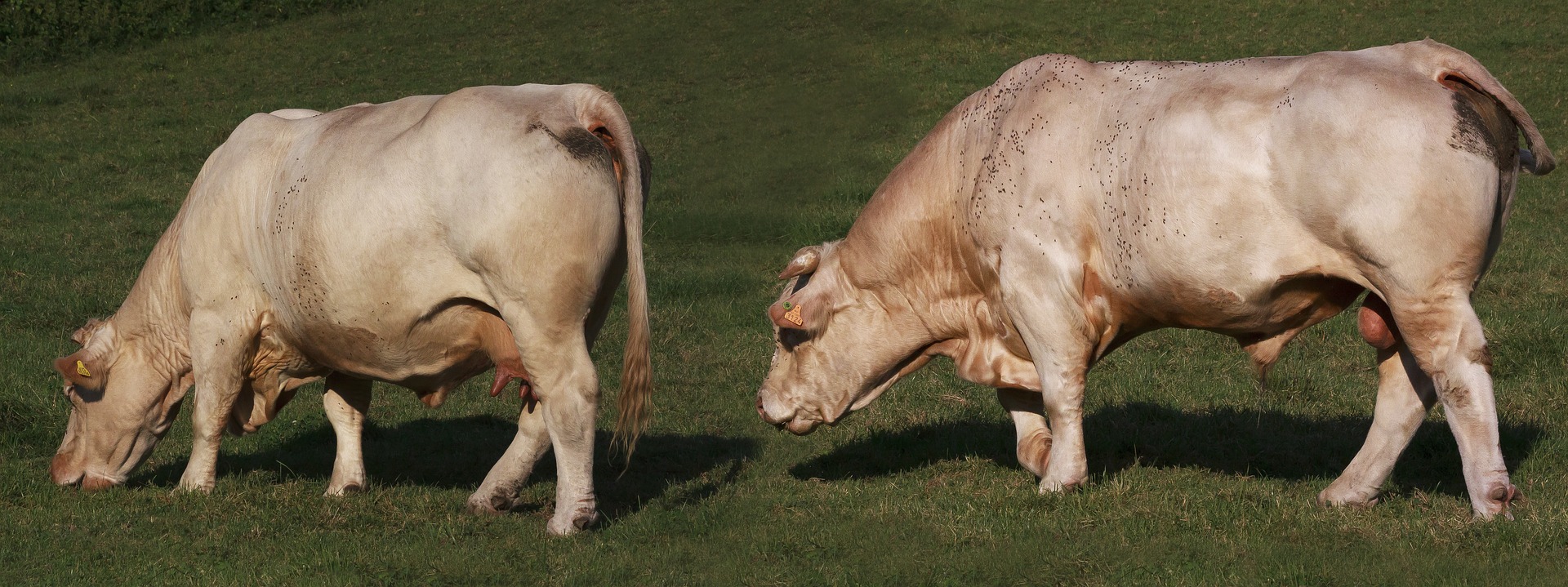
Cows want to be bred when they’re in estrus. They’re not going to try to resist the amorous attempts of a bull especially when they’re ready to breed. Even bulls can be overly pushy when it comes to breeding, as they will chase and pursue and repeatedly test and try to mount a cow that isn’t even in standing heat yet. It can get pretty rough with a bull; even more so when there’s more than one bull who wants that cow. Fights can break out, penises can get busted, bulls can come up lame, and a cow can get mounted so often that her back end gets raw and most of the hair rubbed off. Big bulls who don’t know their massiveness (and I’m not talking penile size either) can crush the pelvis of a smaller cow or heifer, causing her to come up lame or end her life come calving. And vegan activists think that natural breeding is better?
Speaking of ignorance and being disconnected, how about them rape racks?
Rape Racks: Figments of Animal Activists’ Wild Imaginations
Rape racks don’t exist in the animal agriculture industry.
Yes, that’s really cutting it to the quick, but the reason I say that is because I personally have never heard of rape racks before until I read somewhere online some vegans were claiming that rape racks really were a thing and were what farmers (mostly targeting dairy farmers) would call such restraining apparatuses. Even PETA, per the quote at the beginning, makes such a claim; they claim that it’s a term that comes from the industry.
There’s one very big problem, which is the proverbial elephant in the room: I have done an exhaustive search to find out if such claims were true, and absolutely nothing supports such claims.
In other words, PETA and all those other vegan animal activists are blatantly lying.
I even did a Google search to see if ANY industry publications, any industry blogs, any governmental websites, any books on the subject of breeding animals artificially bear such a term.
NOTHING. Not a damn thing.
Did you know that the only sources where the term “rape rack” is so freely used is on vegan animal activist websites, blogs and social media posts? That’s right. Doing a quick Google search (Google Images is even better) tells a lot:
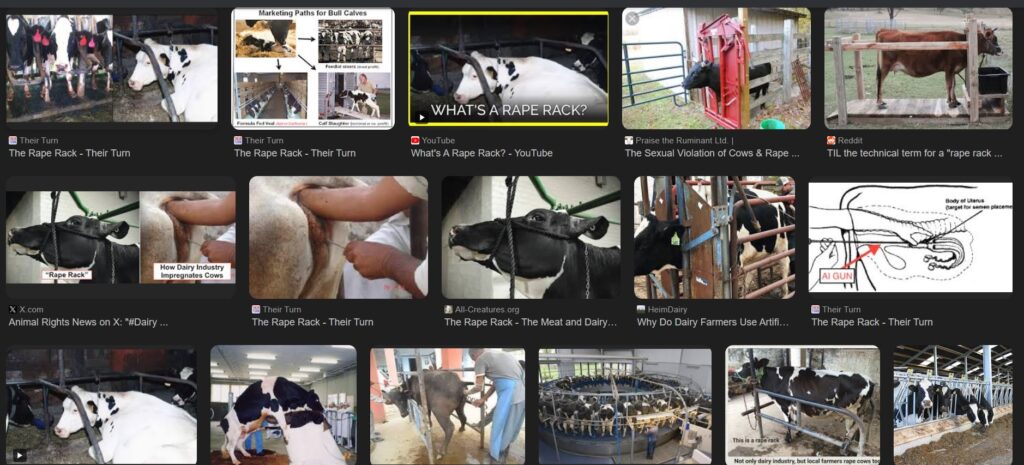
The only book that showed a so-called “rape rack” is M. E. Ensminger’s Beef Cattle Science. It showed an illustration of a breeding rack used in the 1970s. It is a piece of restraining equipment that is rarely used today.
Far more realistic equipment, known as squeeze chutes, is used to restrain cows and heifers for artificial insemination, like the ones shown above and here.
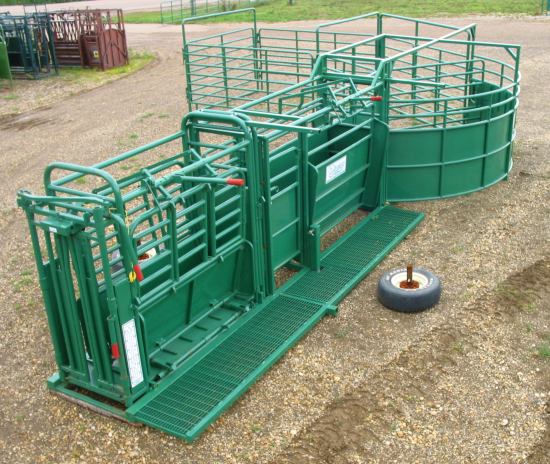
The other holding equipment used has several names: headlocks, headgates, stanchions, feed gates, self-locking feed fences, etc. Again, not “rape racks.”
Here are some other examples of restraining equipment used to hold cattle.
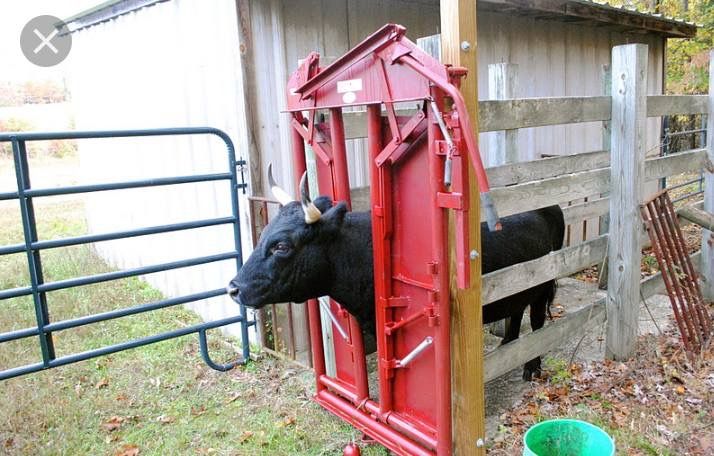
Why do such restraining tools exist?
Mainly because cows don’t understand when you’re trying to help them nor what you’re trying to do to them. They don’t speak human, and they don’t understand us when we try to talk to them to tell them what we’re about to do like with another human being.
Thus because of that, restraining them keeps them safe and from getting into trouble, and it also prevents them from running away. Such equipment also helps keep the handlers safe in case things go wrong.
Squeeze chutes and the other head-restraining equipment I showed you above is not only great for use when a cow needs to be AI’d, they’re also handy for when animals need to be vaccinated, or pregnancy checked, or treated for some kind of illness or parasite that is afflicting them. They’re also great for checking how fat or thin a cow is (called body condition scoring), especially when a cow is not used to close human contact like with a house pet.
Such equipment is a big must-have on any farm with livestock. They’re a far greater tool than what the vegan animal activists want us to believe.
To Answer the Question…
At the very, very beginning of this post, I asked if it’s true or false that cows are actually commonly sexually violated and if rape racks exist?
I believe we can safely sit here and agree that both counts are a complete fallacy.
Artificial insemination is not a brute-force, violent act like what activists have so lovingly written about time and time again. As a matter of fact, A.I. is rather gentle and easy-going, and not this forced fantasy that I exposed via the quotes above. If AI was done forcefully, that means a cow is damaged and in pain, and an AI tech needs to find another business that doesn’t involve working with cows.
AI is also only about getting animals pregnant. It’s not about dominance or sexual deviancy. It’s only sexual deviancy when forced bestiality is committed to an animal that probably never wanted to engage in such an atrocious act in the first place. Speaking of consent, as far as that is concerned, think about giving consent the next time you need to take your cute new puppy in to get spayed or neutered or to get their annual vaccinations. It’s not up to the animals to make the decision for their well-being, that’s up to us, the care-takers of those animals. We are responsible for determining what’s best for them.
Are cows being raped when artificially inseminated? The verdict is in, the jury has made their decision, and the answer is a big fat NO. Because cows go into estrus, where they are actively seeking a mate, and estrus is the only time when a cow can become pregnant, and because bulls are very dangerous to people (plus they can hurt the females they mate with), A.I. is a good tool to use to ensure a cow will come into calf (get pregnant). The whole thought that cows are “raped” when being inseminated artificially is just plain ludicrous.
Finally, “rape racks” are a mythological piece of equipment that doesn’t exist in the animal agriculture industry of today. No evidence points to their existence, except highly biased and highly untrustworthy sources like PeTA, HumaneMyths.org, and other vegan animal activist websites, articles, books, social media posts, and so on.
I guess that leaves only one thing, a lesson to be learned here: Don’t trust anything that comes from vegan sources. They’re most likely misleading or just plain wrong.

0 Comments